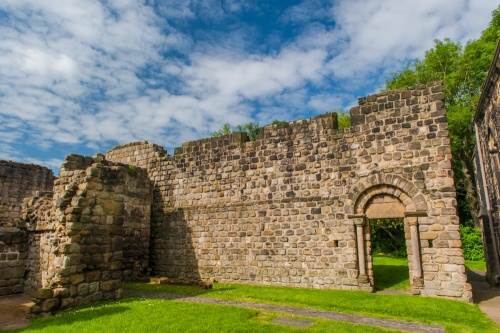
Biscop obtained a grant of land at Wearmouth from Ecgrifth, King of Northumbria, and there he established St Peter's monastery. He obtained a second grant of land at Jarrow, where he established St Paul's monastery in about AD 681.
Jarrow is best known as the home of the prolific 8th-century chronicler, the Venerable Bede. Bede was a monk at both Wearmouth and Jarrow from the age of seven until his death in AD 735. During that time he wrote some of the most influential works of his time, including the Ecclesiastical History of the English People, the first serious attempt to record the history of Britain.

In the centuries following Bede's death the monastery declined and might have disappeared altogether if it were not for Aldwin, prior of Winchcombe, Gloucestershire. Prior Aldwin was inspired by reading Bede's History and undertook to visit the holy sites of Northumbria. When he found Jarrow in decay, he applied to the Bishop of Durham for permission to refound the monastery. This was granted, and around 1070 Aldwin rebuilt the Saxon abbey on a Benedictine plan.
The Saxon monastery was re-established in the 11th century, and it is the ruins of this Norman building that we can see today. Some features of the Saxon church were preserved, however, notably in the chancel of St Paul's church. Here you can see the dedication stone of the Saxon church, dated to AD 685, making it the oldest surviving dedication stone in England.
St Paul's church was begun in AD 681, and parts of that Saxon building still survive as the chancel. There were actually two churches serving the monastic community, and the larger of the two is now buried under the nave of the current church.

St Paul's at Jarrow is one of the most studied monastic sites in Britain, and as a result, we know a lot about how the site developed and how the monks lived there.
Though owned by English Heritage, Jarrow Priory is operated by Bede's World, which is only a short stroll from the monastery. Bede's World is a museum dedicated to the Venerable Bede, and contains a wealth of information on this remarkable man, and includes interactive exhibits aimed at giving visitors a real sense of life in Saxon Britain.
 We've 'tagged' this attraction information to help you find related historic attractions and learn more about major time periods mentioned.
We've 'tagged' this attraction information to help you find related historic attractions and learn more about major time periods mentioned.




